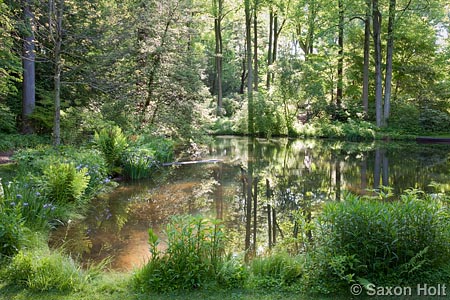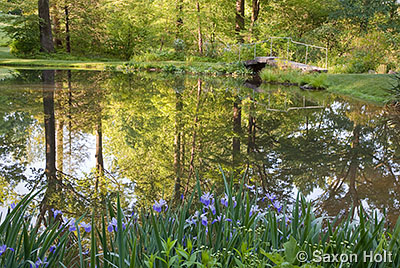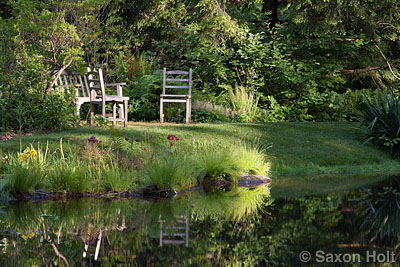I am a light stalker with my camera. Finding the best time and the best light to photograph a garden factors into every shoot. These days I am challenging myself to bring sunlight into my photographs.
Whenever I give presentations and workshops, I always talk about light – about soft light versus hard light. The worst light is bright noontime sun that creates harsh shadows and contrasty, metallic colors. High fog, the equivalent of a studio softbox, has always been my hope, but recently I have been looking for sunlight.
Dawn on a clear morning. Sigh. Breathe out. Fresh, fresh, fresh clean light. Relax and receive what can not be touched. Dawn when all is possible. Dawn, the promises of the day hint at exquisite joy. Frame up the camera. Study the composition. Squeeze off a frame.
Now run Saxon. Run for the light while it holds. You have not long here, and may never have this chance, in this garden again. Run! Across that stone bridge, the light kisses the chairs ! Get it, before the sun rises another inch.
Breathe now, breathe, slow. Focus. focus. Where to ? Careful, turn slowly … drink it in … think .. what am I really seeing … seeing… Oh, I bet these same chairs look good in this light from across the pond with a telephoto lens. Go. The light will not wait.
All this high drama comes from a shoot last week at Mt Cuba Center, the fabulous Delaware garden dedicated to the study of native plants of the Appalachian Piedmont. Thank goodness I was granted early morning access so that this lumbering photographer with tripod slung over his shoulder like a bazooka and camera vest full of ammo (lenses) didn’t scare any visitors as he ran across the garden.
I went to Mt Cuba as part of a project on sustainable gardens. I had visited 20 years ago and was most pleasantly pleased to see how little it had changed. The same chairs, the same little row boat in the pond, the trees seemed to have hardly grown. The garden had been sustained. The only way to show sustainable gardens is not by talking about what might be, but by showing what is and what has been sustained.
Much more on this later, but this day I was not thinking about sustainability, or native plants, or exquisite gardens, I was caught up in the dawn’s early light. Those of you who follow my postings here know I have been playing with sunlight in my photographs recently. It is really hard to get it just right. The light changes so fast at the beginning and end of the day, yet it can work because the shadow areas are not black holes and the dynamic range between the soft early light and the shade can be held with a good camera.
This may look like a simple scene but the streak of early light that kissed this bed of native groundcovers and reflected in the pond happened in an instant (well, maybe five minutes) and was gone. The photographer has to be there, be ready, and know what is happening. The shadows are not yet dense in the early morning and the sunlight is not yet bright. The chairs in the shade convince us it is a garden, the rocks in the water give us some balance, and the lit groundcovers give us triangles and direction for the composition.
The woodland garden provided more time to work with the sunlight than an open garden would, as the overall lighting is still shady. Note how in all these photos there is a definite sense of light but it is coming through trees – shade still dominates. I think this is the trick I am learning. Work in the soft light of shade but find light streaking in. Overexpose and back light sometimes, underexpose sometimes to let the highlights be correct. Such as this Trillium.
A couple hours after sunrise the light was getting hard and I thought I was done with my experiments with sunlight, but still walking the garden and retreating into the true shade. I saw these Wakerobins and framed up a shot just as a most gentle streak of light moved across the woodland floor spotlighting leaves and flowers as it wandered. I was just plain lucky to already have my camera and tripod set up and ready to photograph light kisses.






